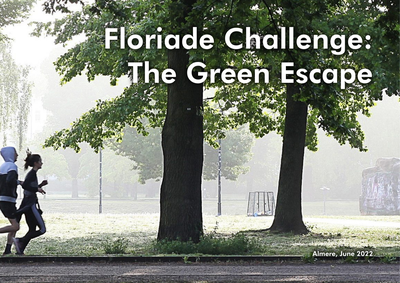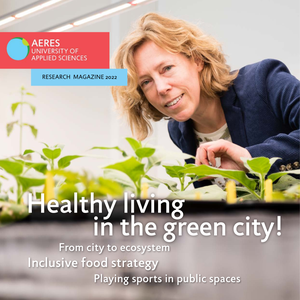The concept of Smart Healthy Age-Friendly Environments (SHAFE) emphasises the comprehensive person-centred experience as essential to promoting living environments. SHAFE takes an interdisciplinary approach, conceptualising complete and multidisciplinary solutions for an inclusive society. From this approach, we promote participation, health, and well-being experiences by finding the best possible combinations of social, physical, and digital solutions in the community. This initiative emerged bottom-up in Europe from the dream and conviction that innovation can improve health equity, foster caring communities, and sustainable development. Smart, adaptable, and inclusive solutions can promote and support independence and autonomy throughout the lifespan, regardless of age, gender, disabilities, cultural differences, and personal choices, as well as promote happier and fairer living places.
DOCUMENT

Het strategisch project Citizen Science for a Healthy Lifestyle is gestart op 1 november 2019. Het project had als doel: kennis, ervaring, scholing en internationalisering op het thema Citizen Science for Healthy Lifestyle bevorderen. Deze strategische fonds heeft op concrete wijze vorm en inhoud gegeven aan de visie en doelen van het CoE HA. Deze aanvraag heeft mede geleid tot het benoemen van Citizen Science als belangrijke enabler/versneller binnen de visie van het CoE HA. In jaar 1 lag het accent op scholing (expert conference/workshop etc.) en de opzet van een 3-tal pilots. In jaar 2 werd de opgedane kennis en ervaring verwerkt in ontwikkelde onderwijs modules Citizen Science. De Hanzehogeschool stelt zich tot doel waarde en impact te cre ren in Noord-Nederland, met de inzet van onderwijs, onderzoek en innovatie. De strategie van het Centre of Expertise Healthy Ageing (CoE HA) belicht drie thema’s: 1) gelijkheid en participatie in gezondheidszorg, 2) gezonde leefstijl en omgeving, en 3) kwetsbaarheid en passende zorg. Zowel als onderzoek/innovatiestrategie en als middel om burgers en gemeenschappen te betrekken, speelt Citizen Science for health een belangrijke rol in het mogelijk maken en versnellen van processen binnen de drie thema’s. Citizen Science kan gedefinieerd worden als een vorm van onderzoekssamenwerking en co-creatie die burgers betrekt bij onderzoek en innovatie om concrete vraagstukken aan te pakken, en die dus vereist dat niet-professionele bijdragers onderdeel van de samenwerking zijn.Belangrijkste resultaten:• Citizen Science is mede door deze strategische fonds aanvraag en van de drie enablers geworden in de nieuwe CoE HA strategische koers 2021-2026;• Opstart pilots van Living Lab Beweegvriendelijk Vinkhuizen, Living Lab Oldambt Tijd voor Toekomst en Meer Gezonde Jaren Appingedam. Mede door blijvende investering en honorering van Living Labs Sport en Bewegen van ZonMw; Het gaat hier om een netwerksubsidie (8 maanden), lokale verankering (12 maanden) en experiment subsidie (5 maanden);• Integratie Citizen Science in Erasmus+ capacity building project Sustainable Wellbeing (SUSWELL);• Ontwikkeling SPRONG-aanvraag op het thema Citizen Science (deadline 31 mei 2022);• Diverse scholingsactiviteiten en workshops (master HAP, bachelor, docent-onderzoekers van de Healthy Ageing schools, studiedagen) hebben in 2020, 2021 en 2022 plaatsgevonden;• Studie tweedaagse over Citizen Science gehouden voor studenten en docent-onderzoekers CoE HA en KC Noorderruimte;• Samenwerking met Stanford University en Our Voice: Citizen Science for Health Equity network gerealiseerd;• Positioning statement Citizen Science geschreven in NL en EN;• Lid geworden van European Citizen Science Association (ECSA);• Scholingsmateriaal ontwikkeld voor studenten en docent-onderzoekers van de vijf schools vallend onder Healthy Ageing;• Ontwikkeling NWO-subsidie aanvraag maatschappelijk verdien vermogen over citizen-student Science voor studenten welzijn tijdens en na de Corona pandemie (deadline voorjaar 2022);• Postdoc aanstelling Citizen Science vanuit het CoE HA.• Met de Citizen Science scholingsactiviteiten zijn in totaal 270 bachelor studenten, 145 master studenten, 279 docent-onderzoekers, 109 professionals en 180 burgers bereikt verspreid over de verschillende pilots.Aanbevelingen:• Mede op basis van de impact van praktijkgericht onderzoek op praktijk, onderwijs en onderzoek (PRIME-model pagina 29), doorgaan met onderwijs en praktijk ontwikkelingen. De bijdrage aan het wetenschappelijke/onderzoeksdomein op Citizen Science verdient dekomende jaren extra aandacht;• Mede op basis van bevindingen visitatie terugkoppeling CoE HA (6-7 april 2022), verder doorontwikkelen tot herkend en erkend expertisecentrum op Citizen Science in de context van (publieke) gezondheidsdomein;• De komende jaren verder investeren in mensen en middelen in Citizen Science zodat het een van de leidende aanpakken wordt binnen onderwijs-onderzoek binnen het CoE HA zodat de Hanze zich ontwikkelt tot een expertisecentrum (o.a. m.b.v. SPRONG);• Komende jaren verder kennis en expertise ontwikkelen op Citizen Science door eigenonderzoek (promovendi/postdocs) en scholing;• Citizen Science integreren in relevante onderzoeksprojectaanvragen;• Citizen Science verder integreren in de drie inhoudelijke thema’s van het CoE HA;• Citizen Science onderwijsmodules en scholingen implementeren in het onderwijs van studenten (bachelors, masters) en bij- en nascholing van docent-onderzoekers.
DOCUMENT

HB2006 : proceedings of the 8th international conference healthy buildings. Oliveira Fernandez, E. de; Gameiro da Silva, M.; Rosada Pinto, J. (red). ISBN 989-95067-1-0 2006 4-8 juni, Lissabon, Portugal, volume III, p. 279-282
DOCUMENT

Rural areas in the northern parts of the Netherlands have lots of potentials to provide a healthy environment for their residents. However, population changes (ageing, outmigration) have a negative impact on the quality of life of residents. The GO!-Method that has been developed by the National Institute of Public Health and Environment (RIVM) in The Netherlands is used in this study. It allows us to identify the opportunities and needs in a systematic way and combine local knowledge by involving residents and local authorities with results of research for a sustainable move towards a healthier environment. Our presentation will focus on the GO!-Method as a bottom up method and its use in identifying threats and changes in realising a healthy living environment.
DOCUMENT

The Northern region of the Netherlands has beautiful landscapes, a nice diversity of green and blue areas, and dispersed settlements. However, some recent population changes can become threats to health and wellbeing in these areas.The rural areas in the three northern provinces - Groningen, Friesland and Drenthe, see youngsters leave the region for which reason they are aging faster than other regions in the Netherlands. As a result, some villages have faced major population decline that is leading to lose of facilities/amenities and decrease in accessibility and social cohesion. Those who still live in these villages; are relatively old, low educated and have low-income. To develop a deeper understanding of the health status of the people living in these areas, and help them to improve their living environment, the GO!-Method is being applied in this study. This method has been developed by the National Institute for Public Health and the Environment (RIVM) of the Netherlands and is inspired by the broad definition of health by Machteld Huber: the ability to adapt and direct control, in terms of the physical, emotional and social challenges of life, while paying extra attention to vulnerable groups. A healthy living environment is defined as an environment that residents find it pleasant, and encourages and supports healthy behavior. The GO!-method integrates six domains that constitutes a healthy living environment: Health and lifestyle, facilities and development, Safety and hygiene, Social cohesion and active citizens, Green areas, and Air and noise pollution.First of all this method will identify opportunities for a healthier living environment using existing information and perceptions of residents and other local stakeholders in order to strengthen social participation and quality of life in these rural areas. Second this approach will connect identified opportunities with available and effective evidence based interventions in order to develop an action plan from the residents and local authorities perspective which will help them to design their municipalities healthier and more resilient. This method is being used for the first time in rural areas to our best knowledge, in close collaboration with the residents and local authorities of the three provinces to create a sustainable process and stimulate social participation.Our paper will present the outcomes of the first phase of this project in collaboration with the municipality of Westerkwartier, located in the northwest of the province of Groningen. And will describe the current situation, and identify local assets, opportunities, and policies relating to healthier environment; as well as needs and challenges to achieve goals. The preliminary results show that rural demographic changes in the northern Netherlands have negative impacts on service provisions and social cohesion, and there is a need to understand this complicated situation and improve the quality of life in those areas.
DOCUMENT

Almere is a green city where the greenery extends into the centre through a framework of nature, forests, parks and canals. With this green environment, Almere fulfils an important condition for a liveable city, where it is pleasant to live and work. An important goal for the municipality is to challenge its residents to develop a healthy lifestyle by using that green framework.But what really motivates Almeerders to go outside to exercise, enjoy the surroundings and meet each other? Are there sufficient green meeting or sports facilities nearby? Could the routes that connect the living and working environment with the larger parks or forests be better designed? And can those routes simultaneously contribute to climate adaptation?With the Green Escape Challenge, we invited students and young professionals to work on these assignments together.
DOCUMENT

With the beautiful new building of Aeres University of Applied Sciences Almere in the Floriade park, we have materialized our wish to lead the way in the green transition and its challenges. We want to be green changemakers and have the ambition to take on the challenges that we are faced with in agriculture, food and healthy living environments. We bring this about with our study programmes and increasingly with our Practice-Based Research Team. In 10 years’ time, this team has grown from our first professorship into a mature team of 20 people, of whom 7 are research professors.In this edition, three of our new professors will be introduced to you.
DOCUMENT

The ageing population demands designing environments while considering their functional needs, desires and wishes. The ICF framework together with the gerontechnological principles can help to have focus on how to adjust or to (re)design the environment for this population. This paper focuses on building-related environmental factors including eHealth solutions. Knowledge and understanding of how the environment is perceived by older people help to set the building performance requirements and gives direction to improve our research to create healthy environments for future users.
LINK
For the needs analysis, an assessment of the national (and local) status quo in the area of Healthy Ageing, specifically towards Active and Healthy Lifestyles. This status quo will serve as important starting point for the exploration of a potential shared goal of the local community of practice. This needs analysis report includes generic sections towards definitions and methodologies, and an introduction towards the topics assessed. Secondly, national/ local chapters will outline the situation in the communities of Groningen (the Netherlands), Odense (Denmark), Malaga (Spain), Kaunas (Lithuania) and Cascais (Portugal). Within each local COP chapter the partners taking part of the COP are described and the shared goals illustrated. These shared goals are: COP Groningen: “stimulating a Healthy environment (physical & social) with focus on physical activity”. COP Odense: “further develop and educate professionals who work on stimulating physical activity in community dwelling older adult”’. COP Malaga: “developing, implementing and evaluating outdoor fitness” COP Kaunas: “to provide opportunities for primary school children and Kaunas district community members older than 50 more opportunities for exercising and physical activity” COP Cascais: “develop, organize for and together with the stakeholders and end users (youngsters from 12-24 years old) activities focused on healthy lifestyle (e.g., healthy cooking workshops, parent-child physical activities etc.) embedded in approach GERAÇÃO S+ “.
DOCUMENT
